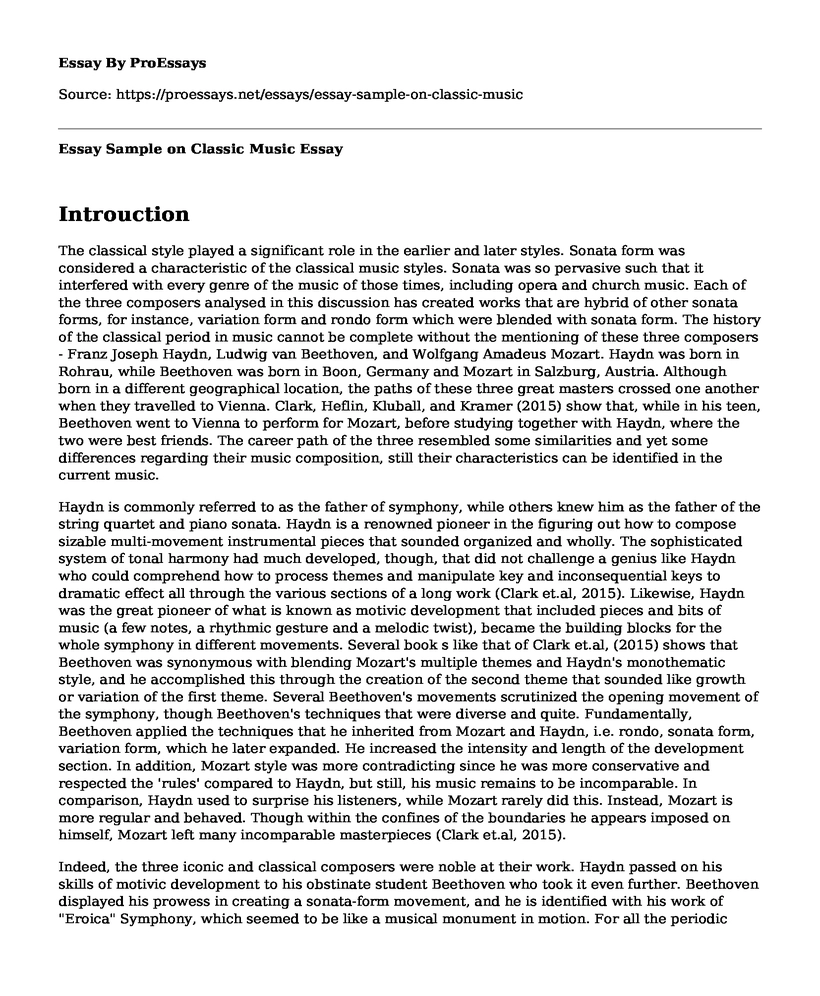Introuction
The classical style played a significant role in the earlier and later styles. Sonata form was considered a characteristic of the classical music styles. Sonata was so pervasive such that it interfered with every genre of the music of those times, including opera and church music. Each of the three composers analysed in this discussion has created works that are hybrid of other sonata forms, for instance, variation form and rondo form which were blended with sonata form. The history of the classical period in music cannot be complete without the mentioning of these three composers - Franz Joseph Haydn, Ludwig van Beethoven, and Wolfgang Amadeus Mozart. Haydn was born in Rohrau, while Beethoven was born in Boon, Germany and Mozart in Salzburg, Austria. Although born in a different geographical location, the paths of these three great masters crossed one another when they travelled to Vienna. Clark, Heflin, Kluball, and Kramer (2015) show that, while in his teen, Beethoven went to Vienna to perform for Mozart, before studying together with Haydn, where the two were best friends. The career path of the three resembled some similarities and yet some differences regarding their music composition, still their characteristics can be identified in the current music.
Haydn is commonly referred to as the father of symphony, while others knew him as the father of the string quartet and piano sonata. Haydn is a renowned pioneer in the figuring out how to compose sizable multi-movement instrumental pieces that sounded organized and wholly. The sophisticated system of tonal harmony had much developed, though, that did not challenge a genius like Haydn who could comprehend how to process themes and manipulate key and inconsequential keys to dramatic effect all through the various sections of a long work (Clark et.al, 2015). Likewise, Haydn was the great pioneer of what is known as motivic development that included pieces and bits of music (a few notes, a rhythmic gesture and a melodic twist), became the building blocks for the whole symphony in different movements. Several book s like that of Clark et.al, (2015) shows that Beethoven was synonymous with blending Mozart's multiple themes and Haydn's monothematic style, and he accomplished this through the creation of the second theme that sounded like growth or variation of the first theme. Several Beethoven's movements scrutinized the opening movement of the symphony, though Beethoven's techniques that were diverse and quite. Fundamentally, Beethoven applied the techniques that he inherited from Mozart and Haydn, i.e. rondo, sonata form, variation form, which he later expanded. He increased the intensity and length of the development section. In addition, Mozart style was more contradicting since he was more conservative and respected the 'rules' compared to Haydn, but still, his music remains to be incomparable. In comparison, Haydn used to surprise his listeners, while Mozart rarely did this. Instead, Mozart is more regular and behaved. Though within the confines of the boundaries he appears imposed on himself, Mozart left many incomparable masterpieces (Clark et.al, 2015).
Indeed, the three iconic and classical composers were noble at their work. Haydn passed on his skills of motivic development to his obstinate student Beethoven who took it even further. Beethoven displayed his prowess in creating a sonata-form movement, and he is identified with his work of "Eroica" Symphony, which seemed to be like a musical monument in motion. For all the periodic shifts and turn of this piece, most of the music that is heard even today, are developed from a handful of motifs. The three classical legends, Mozart, Haydn and Beethoven, all composed the cello sonatas, piano sonatas and violin sonatas (Clark et.al, 2015). Still, we have a similar opinion about their music even in the present days.
References
Clark, N. A., Heflin, T., Kluball, J., & Kramer, E. (2015). Understanding Music: Past and Present. University System of Georgia, University Press of North Georgia.
Cite this page
Essay Sample on Classic Music . (2022, Nov 14). Retrieved from https://proessays.net/essays/essay-sample-on-classic-music
If you are the original author of this essay and no longer wish to have it published on the ProEssays website, please click below to request its removal:
- Test on French Cinema
- Social Commentary Song "Just Imagine" by John Lenon
- Instances Proving That Women Are Treated Inferior to Men in Handmaid's Tale
- Lincoln Speech Essay
- "The Greatest Movie Ever Sold" by Morgan Spurlock Paper Example
- Documentary Analysis Essay on Ellis Island
- Essay on Film Study: Chinese Filmmakers and Independent Documentary-Maker Feng Yan







